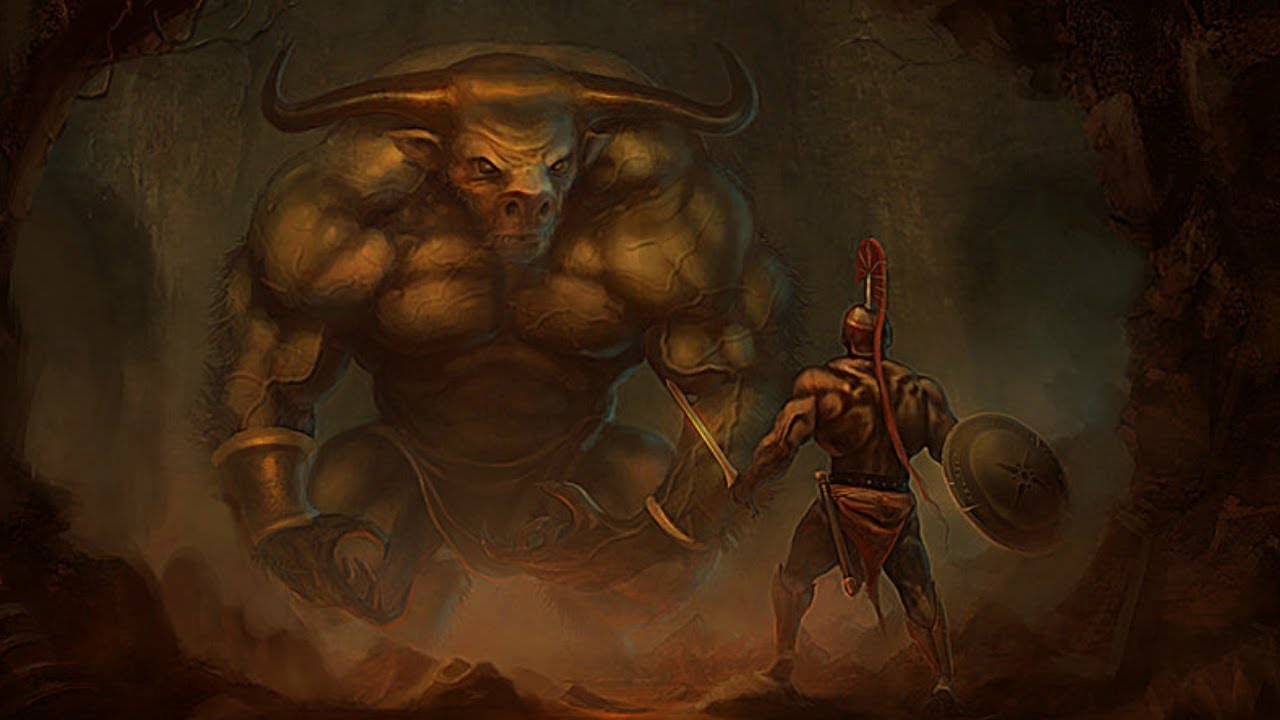The Minotaur Explained – Greek Mythology is a video by Mythology & Fiction Explained that delves into the well-known story of Theseus and his battle with the Minotaur. The video takes you through the origins of the Minotaur, the desperate actions of King Minos, and the ultimate challenge faced by Theseus. It explores the fascinating details of the labyrinth, the role of Daedalus, and the love and betrayal that accompanies the story. If you’re a fan of Greek mythology and want to learn more about the Minotaur, this video is a must-watch.
In the video, you’ll discover the intriguing backstory of the Minotaur and how it came to exist, as well as the events that led to the creation of the labyrinth. You’ll follow the journey of Theseus, who volunteered to face the Minotaur and free Athens from the plague it caused. Along the way, you’ll learn about the role of Ariadne and her clever solution to help Theseus navigate the labyrinth. It’s a captivating tale that will keep you engaged and wanting to learn more about Greek mythology.
Introduction to the Minotaur
Welcome to the captivating tale of the Minotaur! This mythical creature, with the head of a bull and the body of a man, has intrigued countless generations with its ferocity and monstrous nature. In this article, we will delve into the origins of the Minotaur, the life and characteristics of this fearsome beast, the King’s solution to contain it, the Athenian tribute, the role of Ariadne, and the tragic journey back to Athens. So sit back, relax, and prepare to be enthralled by the mythical world of the Minotaur!
The Origins of the Minotaur
The Competition Among Crete’s Future Kings
Long ago, the island of Crete was embroiled in a fierce competition among its future kings. This rivalry originated from King Minos’ throne, which was coveted by his brothers. Determined to secure the throne for himself, Minos sought divine assistance and prayed to Poseidon, the god of the sea, for a sign of approval.
The Desperate Prayer to Poseidon
Minos’ prayer to Poseidon desperately sought a sign that would grant him the kingship of Crete. The god answered his plea by sending a magnificent white bull from the sea, a symbol of divine favor. This majestic creature was meant to be sacrificed as a gesture of gratitude to Poseidon.
The Sacrifice and Anger of Poseidon
However, Minos became captivated by the bull’s unparalleled beauty and decided to keep it instead of offering it as a sacrifice. This decision angered Poseidon, who inflicted a terrible curse upon Minos’ wife, Queen Pasiphae.
The Birth of the Minotaur
As a result of Poseidon’s curse, Queen Pasiphae fell desperately in love with the bull. In a twist of fate, she enlisted the help of the skilled craftsman Daedalus, who created a wooden cow for her. Concealed within the wooden cow, Queen Pasiphae mated with the bull, resulting in the birth of the Minotaur – a hybrid creature destined to cause terror and chaos.

The Life and Nature of the Minotaur
The Beast’s Upbringing and Characteristics
Raised in the darkness of the Labyrinth, the Minotaur grew up with limited human interaction. Its upbringing nurtured a primal and savage nature within the creature. Its physical appearance was that of a man from the waist up, with a powerful, muscular frame. However, from the waist down, it possessed the body of a mighty bull, complete with sharp hooves and a thick, impenetrable hide.
The Monstrous Growth and Ferocity
As the Minotaur matured, its monstrous nature became increasingly apparent. Its physical strength surpassed that of ordinary men, and its ferocity knew no bounds. The mere sight of the Minotaur struck fear into the hearts of those who dared to cross its path.
The Beast’s Insatiable Hunger
One peculiar characteristic of the Minotaur was its insatiable hunger. It constantly craved human flesh, driving the inhabitants of Crete to live in perpetual fear. The Minotaur’s hunger seemed only to be sated by the taste of human blood, making it a truly fearsome and menacing creature.
The King’s Solution: The Labyrinth
The Advice from the Oracle
Desperate to contain the Minotaur’s terrorizing presence, King Minos sought advice from the Oracle of Delphi. The oracle advised the king to construct an intricate labyrinth, a maze so complex that no one who entered it would be able to find their way out. It was believed that this labyrinth would serve as the prison for the Minotaur, forever confining it within its walls.
The Construction of the Labyrinth
Using Daedalus’ remarkable skills, the labyrinth was meticulously crafted, its design a true marvel. Its winding passages and confusing twists ensured that anyone who entered would be doomed to wander aimlessly, unable to escape its clutches. The walls of the labyrinth were built so expertly that even the most determined individual would be hopelessly lost within its depths.
The Possible Fate of the King’s Son
To secure the labyrinth’s construction, King Minos made a pact with Athens. Every year, seven young men and seven maidens would be sent as a tribute to Crete, to be devoured by the Minotaur. Among these unfortunate souls was the king’s son, a decision that would prove to have far-reaching consequences.
The Athenian Tribute
The Declaration of the Sacrifice
Year after year, Athens followed the agreement with Crete, sending its youth as sacrifices to nourish the insatiable hunger of the Minotaur. The declaration of this sacrifice struck fear and sorrow into the hearts of the Athenian people, yet they had no choice but to comply with the terms set by King Minos.
The Voluntary Sacrifice of Theseus
One year, a young hero named Theseus stepped forward and volunteered to be part of the Athenian tribute. Determined to end the terror of the Minotaur, Theseus embarked on a journey that would test his courage and resourcefulness. Armed with his father’s sword, he set sail for Crete, ready to confront the fearsome beast and bring an end to its rampage.
The Promise to Aegeus and Falling in Love
Before leaving, Theseus made a vow to his father, King Aegeus, promising to raise white sails upon his return to signify his triumph over the Minotaur. Along his adventure, Theseus encountered Princess Ariadne, who fell deeply in love with him. Ariadne, driven by her affection for Theseus, vowed to help him in whatever way she could.
The Role of Ariadne
Ariadne’s Love for Theseus
Ariadne’s heart swelled with love for Theseus, captivated by his bravery and determination. She dreamed of a life filled with love and freedom, away from the darkness and terror of the labyrinth. Ariadne’s love for Theseus would prove to be a driving force in their quest to defeat the Minotaur.
Ariadne’s Help: The Thread
Recognizing the labyrinth’s complexity, Ariadne devised a plan to aid Theseus in his mission. She provided him with a ball of thread, instructing him to tie one end to the entrance of the labyrinth and unravel it as he navigated the maze. This thread would serve as a lifeline, leading Theseus back to safety once he had slain the Minotaur.
The Defeat of the Minotaur
With the guidance of Ariadne’s thread, Theseus ventured into the labyrinth, carefully making his way through its treacherous passages. Finally, he encountered the Minotaur, and in a fierce battle, Theseus emerged triumphant. The Minotaur’s reign of terror came to an end, thanks to the determination and heroic acts of Theseus.
The Journey Back to Athens
Abandonment of Ariadne
Despite the defeat of the Minotaur, tragedy befell Ariadne. Theseus, perhaps overcome by the euphoria of victory, chose to abandon her on the island of Naxos. Crippled by grief and betrayal, Ariadne was left alone, abandoned by the man whom she had risked everything for.
Phaedra and Theseus
As Theseus continued his journey back to Athens, he encountered another tragic chapter in his life. He fell in love with Phaedra, the sister of Ariadne, and they got married. However, their love was marred by tragedy and deception, leading to a series of unfortunate events that would forever haunt Theseus.
The Tragic Mistake
Upon his return to Athens, Theseus forgot to raise the white sails on his ship, signifying victory over the Minotaur. King Aegeus, seeing the black sails on the horizon, mistakenly believed that his son had perished in the labyrinth. Overwhelmed with grief, Aegeus threw himself into the sea, resulting in his tragic demise.
Conclusion of the Minotaur’s Tale
Theseus Becomes the new Athenian King
With the death of King Aegeus, Theseus ascended to the throne, becoming the new Athenian king. His triumph over the Minotaur and his heroic exploits cemented his place in history as a legendary figure, celebrated for his bravery and cunning.
The Aftermath of Aegeus’ Death
The death of King Aegeus and the events that transpired after Theseus’ return to Athens marked a turning point in the city’s history. Athens was forever changed by its battle with the Minotaur, experiencing both the depths of tragedy and the heights of heroism. The legend of the Minotaur served as a reminder of the power of determination and the indomitable spirit of humanity.
As we conclude this fascinating tale of the Minotaur, we contemplate the lasting impact of its mythology. Its origins, life, and eventual defeat have inspired countless artists, thinkers, and storytellers throughout the ages. The Minotaur’s story stands as a testament to the power of myth and the enduring fascination with creatures that exist beyond the realms of our imagination.
